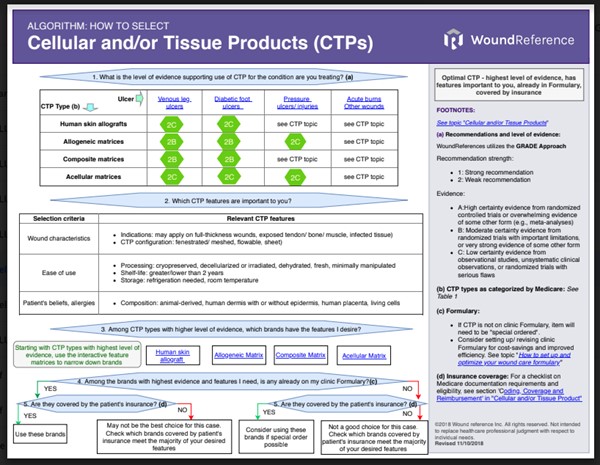Last updated on 3/24/23 | First published on 11/10/18 | Literature review current through Dec. 2025
[cite]
Authors:
Elaine Horibe Song MD, PhD, MBA,
more...
Coauthor(s)
Elaine Horibe Song, MD, PhD, MBACo-Founder and Editor, Wound Reference, Inc;
Professor (Affiliate), Division of Plastic Surgery, Federal University of Sao Paulo;
Volunteer, Association for the Advancement of Wound Care;
Google Scholar Profile
Disclosures: Nothing to disclose
Editors
For full access to this topic and more
premium content, upgrade today. Or get started with a Free Basic account (limited content and tools).
INTRODUCTION
Overview
This topic provides guidance on selection of Cellular and/or Tissue Products (CTPs). For an overview on CTPs from the clinical, coverage and reimbursement perspective, see "Cellular and/or Tissue Products". For decision support on CTP brands, see interactive feature matrices “Human Skin Allografts”, “Allogeneic Matrix”, “Composite Matrix” and “Acellular Matrix”. For custom case discussions, send message to WoundReference advisory panel through Curbside Consult.</span>
HOW TO SELECT AN APPROPRIATE PRODUCT
For successful outcomes, choice of CTPs for each case may be guided by criteria outlined in Algorithm 1 below.

Algorithm 1: Algorithm for Selection of Cellular and/or Tissue Products (click this link to enlarge)
Criteria relevant for decision making is also itemized below:
- Evidence, as defined by availability of RCTs
- Careful weighing of benefits and harms, appropriate product selection for the wound condition
- CTP indications, contraindications and features
- Shelf-life: length until expiration date, storage requirements (room temperature, freezer, refrigerator), need for special equipment for application
- Patient’s and clinician’s preference and familiarity with the product
- Dietary beliefs, religious beliefs, moral beliefs
- Compliance with post-application care
- Availability of resources and cost-effectiveness
- Reimbursement
- See section ‘Coding, Coverage and Reimbursement’ in topic "Cellular and/or Tissue Products"
- Care setting
- Pre-authorization requirements
- Patient co-pay
- Adherence to standard of care [1] :
- Meticulous wound bed preparation, including removal of exudate and necrotic tissue, infection control, nutritional support, pressure avoidance (e.g., offloading for diabetic foot ulcers and pressure ulcers) and edema control (e.g., compression for venous leg ulcers).
- Diligent patient preparation and correction of systemic cofactors that impair healing;
- Aggressive correction of the underlying wound etiology;
- Proper CTP application; appropriate cover dressings;
- Consistent, regular monitoring of both the cover dressings and the wound bed
Official reprint from WoundReference® woundreference.com ©2026 Wound Reference, Inc. All Rights Reserved
Use of WoundReference is subject to the
Subscription and License Agreement.
NOTE: This is a controlled document. This document is not a substitute for proper training, experience, and exercising of professional judgment. While every effort has been made to ensure the accuracy of the contents, neither the authors nor the Wound Reference, Inc. give any guarantee as to the accuracy of the information contained in them nor accept any liability, with respect to loss, damage, injury or expense arising from any such errors or omissions in the contents of the work.